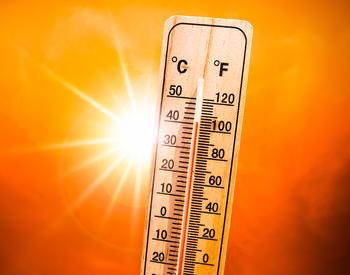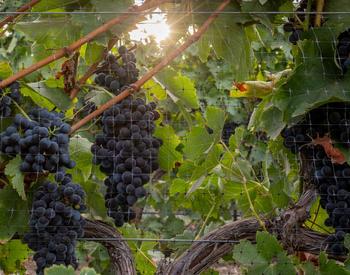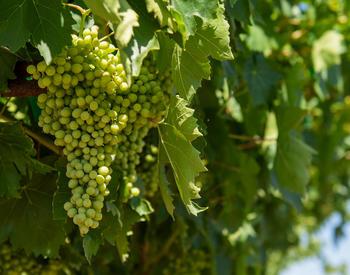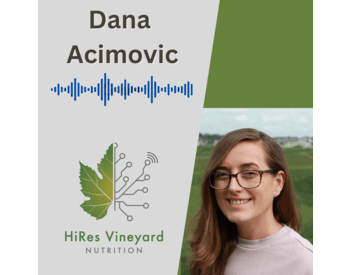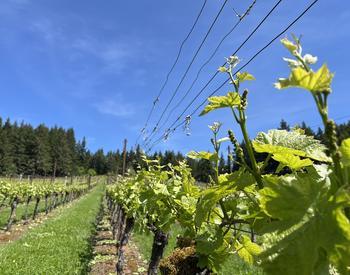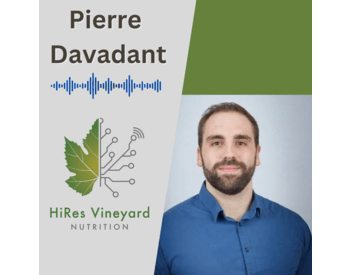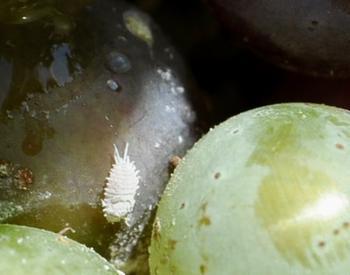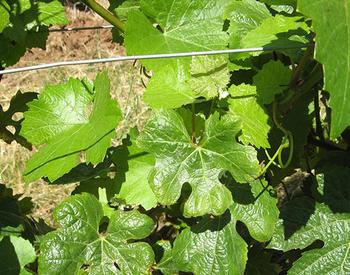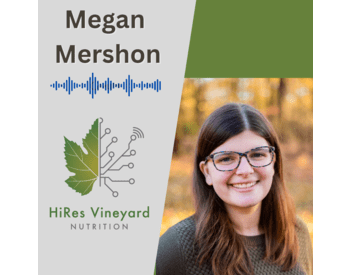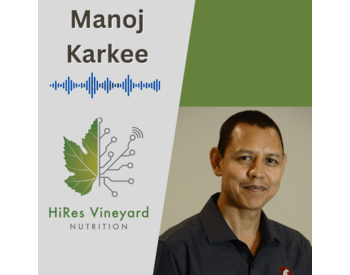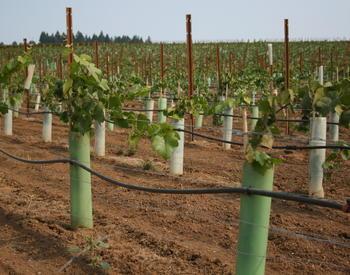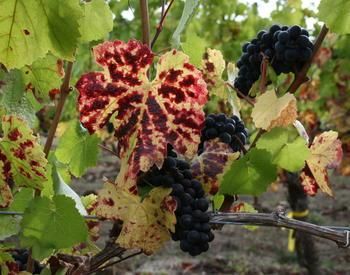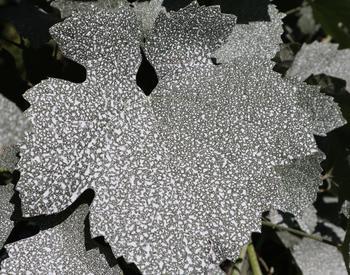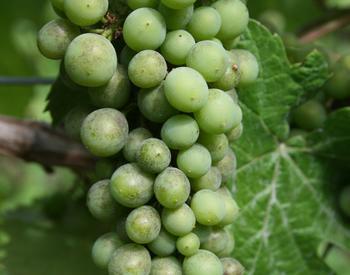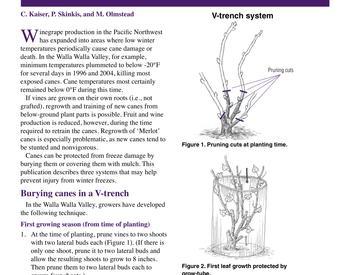Extreme temperatures are a concern for Oregon grape growers, especially in drought areas. The Pacific Northwest experienced record-breaking temperatures in late June 2021. Temperatures reached highs up to 118°F over the period of June 27 to 28 across Oregon grape-growing regions. The frequency and severity of extreme heat events are increasing as mean global temperatures rise due to climate change.
Impact of heat spikes on growth and development
The impacts of heat spikes on vine and berry development vary by the vine’s phenology (growth stage).
Grapevine inflorescences at time of flowering (known as bloom) are sensitive to high temperatures, which can reduce fruit set, leading to fewer berries per cluster. Fortunately, high temperatures (>100 °F) are rare in Oregon during bloom.
The 2021 heat spike occurred after fruit set, so yield was minimally affected. Berries are more tolerant of high heat between fruit set and veraison (start of ripening). However, longer heat waves can reduce yield by restricting berry growth.
From veraison to harvest, yield losses are primarily attributed to desiccation. A warming climate generally advances the onset of ripening and other phenological stages. However, severe heat (> 105 °F) can reduce vine photosynthesis and slow sugar accumulation during ripening.
In addition to yield losses, fruit quality may suffer from high heat spikes due to various effects. Extreme heat can slow sugar accumulation and increase malic acid respiration leading to reduced berry acidity.
Concurrence of high temperatures and cluster sun exposure can impact fruit and wine quality. Sunburn can lead to desiccation and can also increase bitterness and browning in wines from damaged white grapes.
High heat combined with damaging ultraviolet light can lead to the degradation of anthocyanins (red color pigments) and poor color in red wines. The extent of impact scales with the duration and severity of the heat event.
Before a heat spike
Several preventative strategies may be used in the vineyard to reduce the impacts of high heat on grape development and composition.
Irrigation
Irrigation applied in advance of a heat spike can prepare vines for high temperatures. Early season irrigation may be useful if there is uncertain water supply later in the season. Adequate water is essential for maintaining water movement through the vine under high temperatures. This water supply promotes continued growth and canopy cooling through transpiration. Irrigation is as effective as evaporative cooling methods (e.g., overhead watering) and requires no additional infrastructure.
Leaf removal
Fruit zone leaf removal increases cluster sun exposure, reduces disease pressure and improves berry phenolic content. However, increased risk of extreme temperatures may complicate this practice.
Cluster temperature can rise above ambient air temperature when exposed to the sun, especially during a heat spike (Figure 1). Removing fewer leaves will reduce the chance of heat or sun damage to clusters during a heat spike. Leaf removal should be considered in vines with dense canopies and conducted early in the season from around fruit set to bunch closure in order prevent sun damage.
Vineyard floor management
Vineyard floor management can be adapted to changing growing conditions. This is useful under drought conditions or when irrigation is unavailable. Vineyard floor management studies in the Willamette Valley demonstrated that alleyway vegetation does not generally compete with vines for water. It is unclear whether this applies to southern and eastern Oregon’s semi-arid regions.
Tilling the vineyard floor can potentially reduce competition for water under prolonged drought. However, bare soil radiates more heat than a vineyard floor with a cover crop or quiescent sward.
Figure 2 shows the difference in surface temperature between a tilled and untilled vineyard floor during the 2021 heat spike in southern Oregon. Thus, bare soil may exacerbate the impact of heat spikes on fruit closer to the ground. Vineyards facing drought conditions and heat spikes may consider retaining floor cover but terminating growth (e.g., mowing, crimping, herbicides) early in the season.
During a heat spike
The goal is to reduce the temperature of the vine canopy and fruit zone during a heat spike.
Evaporative cooling
Evaporative cooling is the most direct way of reducing canopy and fruit temperatures. Evaporative cooling uses over- or under-canopy sprinklers or misters to apply water to the vine (Figure 3). This method is limited by vineyard infrastructure and water availability.
Evaporative cooling can significantly reduce canopy and fruit temperatures during a heat spike. This method is effective, but not necessarily more than proper vine hydration through drip irrigation. A well-watered vine using drip irrigation will maintain open stomata (leaf pores) during a heat spike to cool the vine naturally through evapotranspiration.
Shade nets
Shade nets used in the fruiting zone will reduce sunburn by intercepting or reflecting light. Note that shade nets are different from bird netting.
Nets of various colors transmit light differently and can alter the phenolic composition of berries. Light-colored nets should be used to reduce temperatures. Anthocyanins may degrade when exposed to high temperatures. Thus, in warm climates, shade nets can improve anthocyanin concentrations. This labor-intensive method may not be useful in cooler climates or during a short heat spike.
Particle films
Particle films with high albedo (e.g., light colored) can reflect more sunlight and reduce vine temperature. Kaolin clay (registered as Surround in Oregon) can be applied to the canopy and fruit before a heat spike. Kaolin can reduce canopy and fruit temperatures and improve berry anthocyanin concentration. Calcium carbonate may have similar effects but has not been extensively evaluated for extreme heat. These films may need to be washed off prior to processing to prevent unwanted effects in the wine.
Vineyard design considerations
Vineyard design and development provide opportunities to reduce vine susceptibility to extreme heat.
Training system
Training system can impact sun exposure and temperature in the fruiting zone. Vertical shoot positioning (VSP) exposes fruit to more sunlight than other training systems. Different training systems or adjustments to the common VSP system can reduce exposure in the fruit zone and increase light exposure in the canopy:
- Relaxed VSP: The shoots are positioned less tightly in the canopy to allow a more open, vase-shaped canopy. This upper canopy provides more shading to the fruit zone below. This may require the addition of cross-arms to allow shoot distribution or may be done by reducing the number of upper canopy catch wires and avoiding over-hedging the shoots.
- Half-sprawl: This variation consists of normal vertical shoot positioning on the morning sun side and shoots are left to sprawl on the afternoon sun side of the canopy.
- Full sprawl (open) training systems can maximize fruit protection from sun exposure. Full sprawl requires a taller head height (trunk and fruiting wire) and often wider rows to facilitate tractor operations and to avoid over-shading. Changing the trellising system can protect the fruit but will also expose more leaf area. Increased leaf area exposure will alter vine water and nutrient requirements, which may be beneficial or detrimental, depending on the climate.
Row orientation
Row orientation should be considered under warming climate conditions, as this influences canopy and fruit sun exposure at different times of day. Using an east-west (or northeast-southwest) orientation with leaf removal only on the northside reduces fruit exposure.
Site selection
Vineyards growing in deep soils with high water-holding capacity are more resilient to heat spikes than vineyards growing on shallow soils. North- or east-facing slopes may provide some relief from the most extreme sunlight and temperatures. Elevation must also be considered in regions with higher frost risk and a more condensed growing season (e.g., eastern Oregon).
Variety selection
Variety selection provides an opportunity to adapt vineyards to a warming climate. Variety selection has been influenced by cultural and market forces, which do not account for heat or drought tolerance.
Mediterranean varieties often have higher heat and drought tolerance than the dominant western European varieties. Oregon's hottest growing regions (southern and eastern Oregon) are more prone to damaging frosts or freezes than the Willamette Valley, and consideration of the varieties grown between these regions is important.
Thorough evaluation is necessary to identify the most promising varieties and clones that will work based on seasonal heat units, required season length, and the location's frost-free days.
Rootstock selection
Rootstock selection influences a vineyard’s resistance to drought and heat spikes. When selecting a rootstock, Oregon growers must balance important traits like drought resistance, vigor and vegetative cycle (time to ripening). Grapevine Rootstocks for Oregon Vineyards (EM 8882) provides general descriptions of rootstock varieties and traits.
Two rootstock trials are currently being conducted by Oregon State University. One is evaluating mature, unirrigated pinot noir in the Willamette Valley. The other is evaluating young, irrigated cabernet sauvignon and pinot noir in southern Oregon. In the future, these trials will provide more guidance for rootstock selection in Oregon’s changing climate.
Further information
Check out the following resources for more information about managing grapevines during extreme heat:
